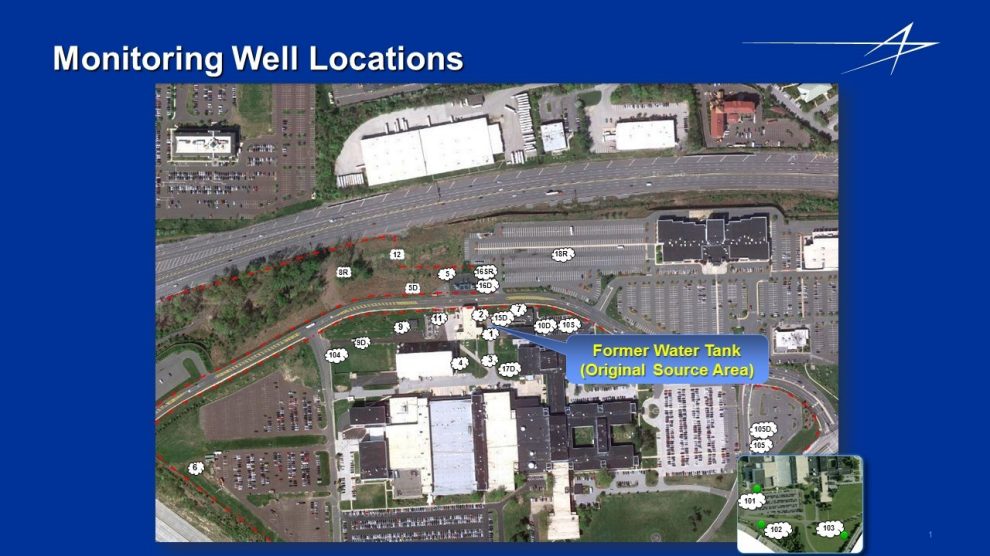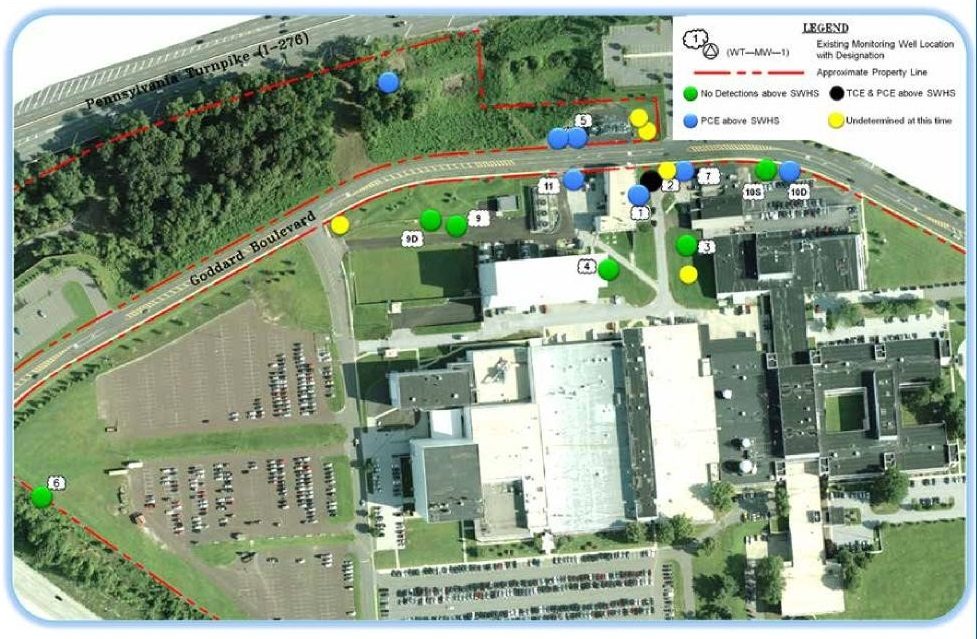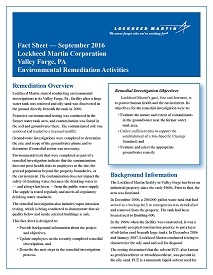Overview
The Lockheed Martin campus in Valley Forge, PA, has been an industrial property since the early 1960s. Lockheed Martin started conducting environmental investigations at the facility after a large water tank was removed from the northern portion of the property and oily sand was discovered in the ground directly beneath the tank in 2006.
- Environmental tests that were completed as part of a remedial investigation indicate that the contamination does not pose health risks to employees at the site, the general population beyond the property boundaries, or the environment.
- The contamination does not impact the safety of drinking water, because the drinking water is — and always has been — from the public water supply. The supply is tested regularly by the water purveyor (Aqua PA) and meets all regulatory drinking water standards.
- Lockheed Martin conducted the voluntary remedial investigation in collaboration with the Pennsylvania Department of Environmental Protection under the Land Recycling and Environmental Remediation Standards Act, commonly called PA Act 2.
- Extensive environmental testing was conducted in the former water tank area, and contamination was found in the soil and groundwater there. The contaminated soil was removed and hauled to a licensed landfill.
- Groundwater investigations were completed to determine the size and scope of the groundwater plume and to determine if remedial action was necessary.
- The remedial investigation also included vapor intrusion testing, which was conducted to demonstrate that air quality below and inside selected buildings is safe.
Investigation & Assessment
A Remedial Investigation Report and Risk Assessment Report were submitted to PADEP and US EPA in September 2014. The Remedial Investigation Report presented the environmental data collected to date and provided interpretations, conclusions, and a description of the recommended remedial approach.
- The recommended approach is to monitor concentrations of groundwater contaminants as they decrease over time through natural processes.
- The rate of decrease will be confirmed through the ongoing collection and laboratory analyses of groundwater samples. PADEP and US EPA have agreed with the recommended remedial approach.
- That information was provided to PADEP and US EPA in a Remedial Investigation Report Addendum in the fourth quarter 2016.
- The Risk Assessment Report presented an evaluation of the data and a determination that there are no potential risks to human health or the environment.
- The Risk Assessment was completed by interpreting data from groundwater, soil, and soil gas samples collected at the site.
Remedial Investigation - Groundwater
The groundwater investigation was initiated in April 2008.
- It has identified perchloroethylene (PCE) at concentrations that exceed the residential Statewide Health Standard (rSWHS) of 5 µg/L at the point of compliance (i.e., property boundary).
- Other organic compounds that have been detected at the site have been at concentrations that attain an rSWHS.
- Lockheed Martin recommended using a Site-Specific Standard for PCE and applying a Statewide Health Standard to other organic compounds detected in site groundwater samples. PADEP and EPA agreed with this recommendation.
- The groundwater plume is present northwest from of the former Building 600 tank area at shallow depths, where PCE concentrations currently range from below the detection level to 1,000 to 4,200 micrograms per liter (µg/L).
- PCE concentrations in the groundwater near the property boundary are typically 100 to 200 µg/L. A groundwater model based on data gathered to date, identified the Schuylkill River and, to a lesser extent, the Upper Merion Reservoir as the likely discharge locations for groundwater from the site.
- The groundwater model predicted that a Site-Specific Standard for PCE of 300 µg/L at the property boundary would be protective of these discharge locations (i.e., no adverse impacts would be detected at the Schuylkill River or Upper Merion Reservoir).

Monitoring Well Locations
Remedial Investigation - Vapor Intrusion
A vapor intrusion investigation consisting of sampling of indoor air, sub-slab vapor, and soil gas was conducted for buildings in the vicinity of the source area.
- Sub-slab (soil gas below the building foundation) and indoor air samples were collected from the following buildings: 100, 300, 500, 550, 600, and 750.
- The investigation results indicated no indoor air quality samples exceeded non-residential Medium Specific Concentrations (MSC) for groundwater-related constituents in Buildings 300, 500, 550, or 750.
- Concentrations of PCE detected in one sub-slab and one indoor air sample collected in Building 600 exceeded the non-residential MSC.
- Concentrations of PCE detected in one sub-slab and one indoor air sample collected in the Tunnel 9000 (T9000) portion of Building 100 exceeded the MSC.
- Since these single detections do not pose a health risk to the employees, all vapor monitoring points were abandoned in December 2017, as approved by PADEP and EPA.

Detection Locations
Community Information
If you have questions, please contact Lockheed Martin Communications.
lm.communications@lmco.com
800.449.4486
Timeline
December 2006 - A 200,000-gallon fire emergency water tank was demolished and removed from the property. Oil-laden sand was observed beneath the former tank location and soil samples were collected for laboratory analysis.
April 2007 - Testing determined that the PCE had not spread to soil beyond the tank area. A groundwater investigation was initiated after it was determined that PCE concentrations in bedrock exceeded Pennsylvania regulatory standards.
March 2008 - The first groundwater monitoring well was installed, and sampling determined that PCE had reached the groundwater.
2008 - 2009 - 12 additional wells were installed to gather more information.
2010 - 2012 - 27 additional monitoring wells were installed, bringing the total number to 40.
September 2014 -A Remedial Investigation Report and Risk Assessment Report were submitted to PADEP and US EPA.
2015 - Collection of samples from the groundwater monitoring wells and the evaluation of potential soil vapor mitigation strategies at T9000 and Building 600.
Fall 2016 - Submit Remedial Investigation Report Addendum.
Fall 2018 – Eleven monitoring wells were abandoned, as they were deemed no longer necessary.
Winter 2018 - Submit Act 2 Groundwater Closure Report. EPA issues the Statement of Basis, which formalizes the final remedial approach.
Available Documents
A Risk Assessment was completed to evaluate potential environmental-related risks to a number of receptors.
The Remedial Investigation Report presented the environmental data collected to date and provided interpretations, conclusions, and a description of the recommended remedial approach.
Due to the size of the Remedial Investigation Report and Risk Assessment Report, these documents will be available upon request.
Remedial Investigation Objectives
Lockheed Martin’s goal, first and foremost, is to protect human health and the environment. Its objectives for the remedial investigation were to:
- Evaluate the nature and extent of contaminants in the groundwater near the former water tank area,
- Collect sufficient data to support the establishment of a Site-Specific Cleanup Standard, and
- Evaluate and select the appropriate groundwater remedy.
View a List of Terms Commonly Used in Relation to General Environmental Remediation Efforts




